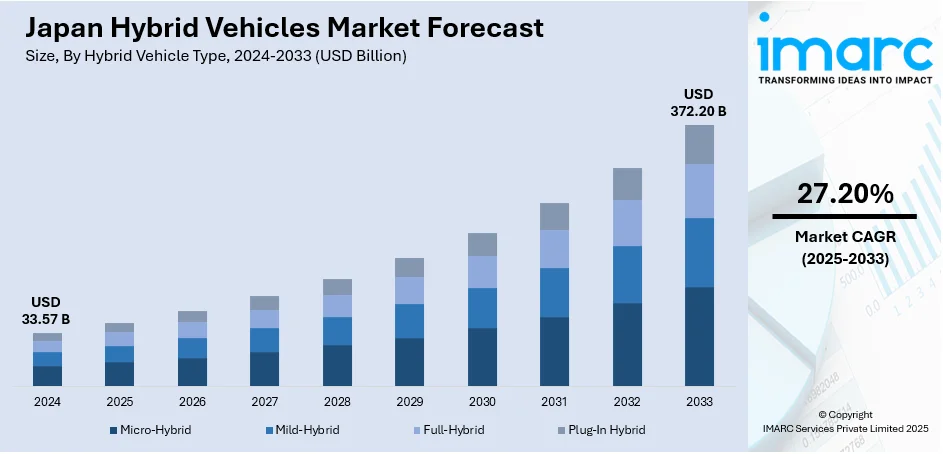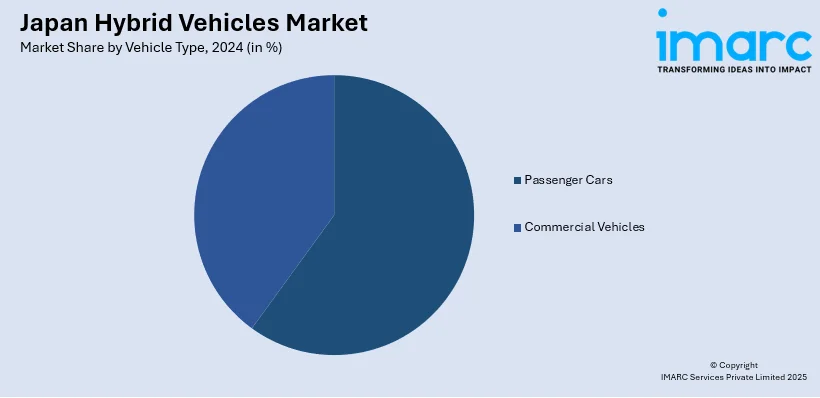
Japan Hybrid Vehicles Market Size, Share, Trends and Forecast by Hybrid Vehicle Type, Vehicle Type, and Region, 2025-2033
Japan Hybrid Vehicles Market Overview:
The Japan hybrid vehicles market size reached USD 33.57 Billion in 2024. Looking forward, IMARC Group expects the market to reach USD 372.20 Billion by 2033, exhibiting a growth rate (CAGR) of 27.20% during 2025-2033. The market is driven by rising fuel prices, which amplify demand for cost-efficient hybrids, supported by consumer preference for long-term savings and superior fuel economy. Government incentives, including tax benefits and subsidies, further stimulate adoption, while automakers enhance hybrid offerings with advanced technologies. Additionally, corporate sustainability goals and Japan’s push toward carbon neutrality reinforce hybrid adoption as a transitional solution, further augmenting the Japan hybrid vehicles market share.
|
Report Attribute
|
Key Statistics
|
|---|---|
|
Base Year
|
2024 |
|
Forecast Years
|
2025-2033
|
|
Historical Years
|
2019-2024
|
| Market Size in 2024 | USD 33.57 Billion |
| Market Forecast in 2033 | USD 372.20 Billion |
| Market Growth Rate 2025-2033 | 27.20% |
Japan Hybrid Vehicles Market Trends:
Rising Demand for Fuel-Efficient Hybrid Vehicles Amid High Fuel Prices
The market is experiencing a rise in demand due to increasing fuel prices and growing consumer preference for cost-effective transportation. As of May 26, 2025, Japan's gasoline prices stand at JPY 182.10 (approximately USD 1.28) per liter, 4.1% higher compared to last year but 1.6% lower than the preceding month. Fuel prices are currently at 92.62% of the worldwide average. With a growing demand for hybrid cars, the trend aligns with Japan's movement towards embracing more efficient technologies that use less fuel. The highest price ever recorded was JPY 186.50 (approximately USD 1.30) on April 21, 2025, compared to a 10-year average of JPY 148.36 (approximately USD 1.03). With gasoline prices remaining volatile, Japanese consumers are prioritizing fuel efficiency, making hybrid vehicles an attractive alternative to conventional gasoline cars. Hybrid models offer superior fuel economy, reducing long-term ownership costs. Additionally, government incentives, including tax breaks and subsidies for eco-friendly vehicles, further encourage adoption. Automakers are responding by expanding their hybrid lineups, incorporating advanced technologies such as regenerative braking and lightweight materials to enhance efficiency. The trend is also driven by corporate fleets transitioning to hybrids to meet sustainability goals. As Japan continues to emphasize carbon neutrality, hybrid vehicles serve as a bridge toward full electrification, ensuring steady market growth in the coming years.

To get more information on this market, Request Sample
Expansion of Plug-In Hybrid Electric Vehicles (PHEVs) for Enhanced Sustainability
The growing popularity of plug-in hybrid electric vehicles (PHEVs), which combine electric driving with gasoline backup is also supporting the Japan hybrid vehicles market growth. PHEVs, such as the Mitsubishi Outlander PHEV and Toyota RAV4 Prime, offer extended electric-only ranges, appealing to environmentally conscious consumers seeking reduced emissions. The Japanese government supports PHEV adoption through subsidies and expanded charging infrastructure, addressing range anxiety concerns. Japan's electric vehicle (EV) industry is projected to reach USD 111.10 Billion by 2030. This expansion is supported by the availability of 31,600 public EV charging points in 2023, as well as targets for 100% electrification of new light-duty vehicle sales by 2035. The charging system is expected to grow to USD 1.54 Billion by 2030 and USD 3.5 Billion by 2045. Considering that hybrid cars currently dominate the green mobility arena in Japan, these developments signal a strong push in infrastructure supporting electric vehicles and hybrids. Automakers are investing in next-gen PHEV batteries to improve efficiency and lower costs, making them more accessible. Urban consumers, in particular, favor PHEVs for short commutes, leveraging electric mode for zero-emission travel. As Japan accelerates its shift toward greener mobility, PHEVs are expected to play a pivotal role in the transition, complementing battery electric vehicles (BEVs) and solidifying their position in the hybrid market.
Japan Hybrid Vehicles Market Segmentation:
IMARC Group provides an analysis of the key trends in each segment of the market, along with forecasts at the country and regional levels for 2025-2033. Our report has categorized the market based on hybrid vehicle type and vehicle type.
Hybrid Vehicle Type Insights:
- Micro-Hybrid
- Mild-Hybrid
- Full-Hybrid
- Plug-In Hybrid
The report has provided a detailed breakup and analysis of the market based on the hybrid vehicle type. This includes micro-hybrid, mild-hybrid, full-hybrid, and plug-in hybrid.
Vehicle Type Insights:

- Passenger Cars
- Commercial Vehicles
A detailed breakup and analysis of the market based on the vehicle type have also been provided in the report. This includes passenger cars and commercial vehicles.
Regional Insights:
- Kanto Region
- Kansai/Kinki Region
- Central/ Chubu Region
- Kyushu-Okinawa Region
- Tohoku Region
- Chugoku Region
- Hokkaido Region
- Shikoku Region
The report has also provided a comprehensive analysis of all the major regional markets, which include Kanto Region, Kansai/Kinki Region, Central/ Chubu Region, Kyushu-Okinawa Region, Tohoku Region, Chugoku Region, Hokkaido Region, and Shikoku Region.
Competitive Landscape:
The market research report has also provided a comprehensive analysis of the competitive landscape. Competitive analysis such as market structure, key player positioning, top winning strategies, competitive dashboard, and company evaluation quadrant has been covered in the report. Also, detailed profiles of all major companies have been provided.
Japan Hybrid Vehicles Market News:
- December 20, 2024: Toyota announced the launch of Japan's first plug-in hybrid minivans, the Alphard and Vellfire, on January 31, 2025, with a goal of selling 200 PHEV units per month. Both six-seaters are equipped with a 2.5L PHEV powertrain that provides a BEV-mode driving range of 73 km, a system output of 225 kW (306 PS), and a fuel economy of 16.7 km/L. Priced at ¥10.65 Million (approximately USD 74,177.25) for the Alphard and ¥10.85 Million (approximately USD 75,581.10) for the Vellfire, these vehicles aim to bolster Japan's hybrid vehicle market with features suitable for chauffeurs and a V2H emergency power supply.
- October 16, 2024: Suzuki launched the all-new Fronx compact SUV in Japan, equipped with a 1.5L K15C mild-hybrid engine and a 6-speed automatic transmission. The Fronx measures 3,995mm x 1,765mm x 1,550mm and features a 4.8m turning radius, along with agile handling suitable for city driving. Additionally, a 4WD variant is available, which is exclusive to Japan. Standard features include smartphone-linked navigation, wireless charging, and advanced safety technologies such as Dual Sensor Brake Support II and adaptive cruise control, enhancing Suzuki’s footprint in Japan’s hybrid vehicle sector.
Japan Hybrid Vehicles Market Report Coverage:
| Report Features | Details |
|---|---|
| Base Year of the Analysis | 2024 |
| Historical Period | 2019-2024 |
| Forecast Period | 2025-2033 |
| Units | Billion USD |
| Scope of the Report |
Exploration of Historical Trends and Market Outlook, Industry Catalysts and Challenges, Segment-Wise Historical and Future Market Assessment:
|
| Hybrid Vehicle Types Covered | Micro-Hybrid, Mild-Hybrid, Full-Hybrid, Plug-In Hybrid |
| Vehicle Types Covered | Passenger Cars, Commercial Vehicles |
| Regions Covered | Kanto Region, Kansai/Kinki Region, Central/ Chubu Region, Kyushu-Okinawa Region, Tohoku Region, Chugoku Region, Hokkaido Region, Shikoku Region |
| Customization Scope | 10% Free Customization |
| Post-Sale Analyst Support | 10-12 Weeks |
| Delivery Format | PDF and Excel through Email (We can also provide the editable version of the report in PPT/Word format on special request) |
Key Questions Answered in This Report:
- How has the Japan hybrid vehicles market performed so far and how will it perform in the coming years?
- What is the breakup of the Japan hybrid vehicles market on the basis of hybrid vehicle type?
- What is the breakup of the Japan hybrid vehicles market on the basis of vehicle type?
- What is the breakup of the Japan hybrid vehicles market on the basis of region?
- What are the various stages in the value chain of the Japan hybrid vehicles market?
- What are the key driving factors and challenges in the Japan hybrid vehicles market?
- What is the structure of the Japan hybrid vehicles market and who are the key players?
- What is the degree of competition in the Japan hybrid vehicles market?
Key Benefits for Stakeholders:
- IMARC’s industry report offers a comprehensive quantitative analysis of various market segments, historical and current market trends, market forecasts, and dynamics of the Japan hybrid vehicles market from 2019-2033.
- The research report provides the latest information on the market drivers, challenges, and opportunities in the Japan hybrid vehicles market.
- Porter's five forces analysis assist stakeholders in assessing the impact of new entrants, competitive rivalry, supplier power, buyer power, and the threat of substitution. It helps stakeholders to analyze the level of competition within the Japan hybrid vehicles industry and its attractiveness.
- Competitive landscape allows stakeholders to understand their competitive environment and provides an insight into the current positions of key players in the market.
Need more help?
- Speak to our experienced analysts for insights on the current market scenarios.
- Include additional segments and countries to customize the report as per your requirement.
- Gain an unparalleled competitive advantage in your domain by understanding how to utilize the report and positively impacting your operations and revenue.
- For further assistance, please connect with our analysts.
 Request Customization
Request Customization
 Speak to an Analyst
Speak to an Analyst
 Request Brochure
Request Brochure
 Inquire Before Buying
Inquire Before Buying




.webp)




.webp)












